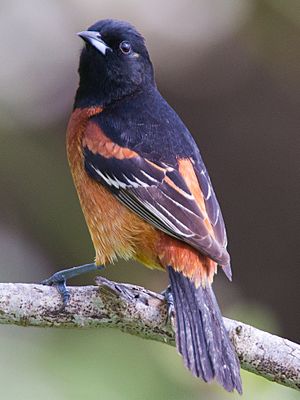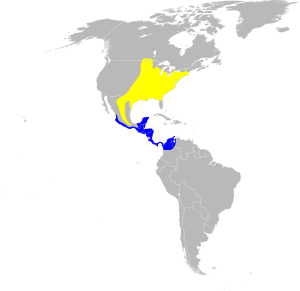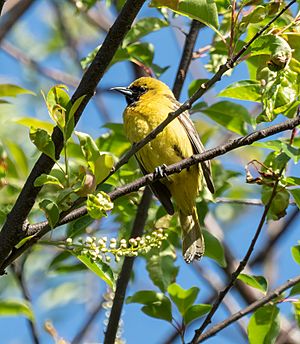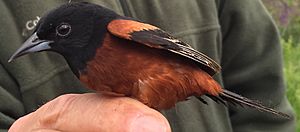Orchard oriole facts for kids
Quick facts for kids Orchard oriole |
|
|---|---|
 |
|
| Adult male I. s. spurius | |
| Conservation status | |
| Scientific classification | |
 |
|
| Range of I. spurius Breeding range Wintering range | |
| Synonyms | |
|
Oriolus spurius Linnaeus, 1766 |
The orchard oriole (Icterus spurius) is the smallest type of oriole bird. It's part of a bird family called icterids. There's a special kind of orchard oriole found along the Caribbean coast of Mexico. It's called I. s. fuertesi, and some people think it's a completely different species, known as the ochre oriole or Fuertes's oriole.
Contents
What Does the Orchard Oriole Look Like?
Orchard orioles are small birds. Here are their average sizes:
- Length: About 5.9 to 7.1 inches (15 to 18 cm)
- Weight: Around 0.6 to 1.0 ounce (16 to 28 grams)
- Wingspan: About 9.8 inches (25 cm)
Their beak is pointed and black. The bottom part of the beak is a bit blue-gray near its base. Adult male orchard orioles of the common type have a beautiful chestnut (reddish-brown) color. This color is on their belly, shoulders, and lower back. The rest of their feathers are black.
However, the I. s. fuertesi subspecies is different. Instead of chestnut, it has an ochre (yellowish-orange) color. Female orchard orioles and young birds of both types look similar. They have olive-green feathers on their upper bodies. Their chest and belly are yellowish. All adult orchard orioles have pointed beaks and white bars on their wings. Birds are considered adults after their second year. Young males, about one year old, are yellow-green with a black patch on their throat.
Where Do Orchard Orioles Live and Travel?
Orchard orioles like to live in open areas with deciduous trees. These are trees that lose their leaves in the fall. The common type of orchard oriole (I. s. spurius) breeds in spring. They are found across eastern North America, from near the Canada–United States border down to central Mexico.
A study in 2009 found them breeding in the thorn forest of Baja California Sur. They were also seen along the coast of Sinaloa during the summer monsoon. Before this, people thought these areas were just places where the birds stopped during migration. The ochre subspecies (I. s. fuertesi) breeds from southern Tamaulipas to Veracruz in Mexico. These birds love shady trees in parks, especially near lakes and streams.
Their nest is like a tightly woven bag. They attach it to a fork in a horizontal tree branch. Their nests often sit close to each other in the same area.
When winter comes, the common orchard orioles fly south. Their winter homes stretch from the coastal areas of central Sinaloa and southern Veracruz. They go all the way down to northern Colombia and northwestern Venezuela. The ochre subspecies spends winter on the Pacific side of Mexico.
Orchard orioles leave their winter homes in March and April. They arrive at their breeding spots from late April to late May. They usually leave their breeding areas in late July and early August. They get to their winter homes in mid-August. These birds fly at night when they migrate.
What Do Orchard Orioles Eat?
During the breeding season, orchard orioles mostly eat insects and spiders. When the season changes, they also enjoy eating ripe fruit. Fruit passes through their bodies very quickly. In winter, their diet changes again. They eat fruit, nectar, insects, and seeds.
How Do Orchard Orioles Behave?
When orchard orioles fly, they usually swoop low to the ground. They fly at or below the height of the treetops.
During courtship, female orioles show off to the males in special ways. One way is by bowing their head and body towards the male. Another display is called "seesawing." This is when they repeatedly lower and raise their head and tail. The third way is called "begging." This involves quickly fluttering their wings, which are halfway open. After this, they make a high whistling sound.
Why Is It Called the Orchard Oriole?
The name spurius comes from a mistake made a long time ago. People first thought the male orchard oriole was a female Baltimore oriole. These birds are sometimes mistaken for New World warblers.
See also
 In Spanish: Turpial castaño para niños
In Spanish: Turpial castaño para niños




